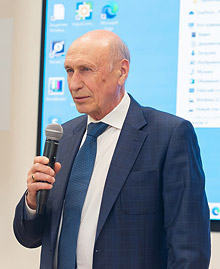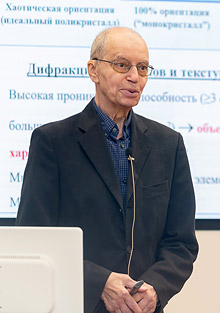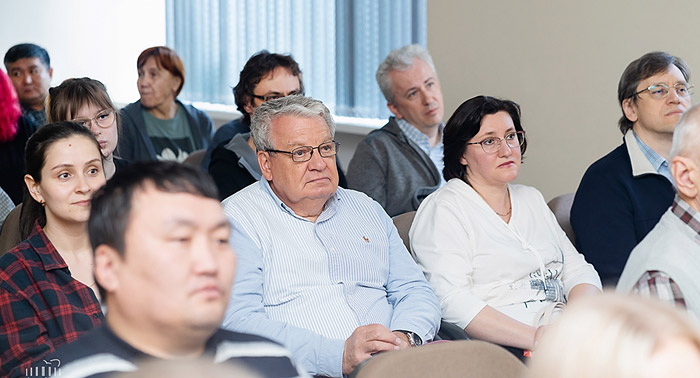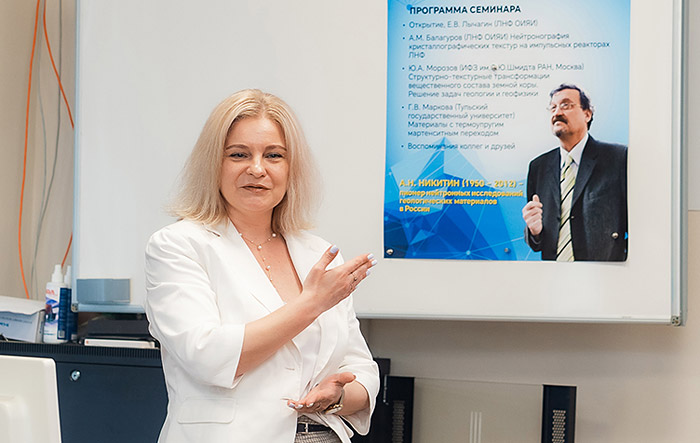
Electronic english version since 2022 |
The newspaper was founded in November 1957
| |
Seminars
Anatoly Nikitin - geologist, physicist, ascetic
On 15 May, a seminar "A.N.Nikitin (1950 - 2012) - a pioneer of neutron investigations of rocks in Russia" was held in FLNP. Laboratory staff and guests from Moscow and Tula gathered in the Conference hall to share memories of their colleague.
 Viktor Aksenov opened the seminar, emphasizing that its programme provides not only memories of Anatoly Nikitin, but also an opportunity to discuss the further implementation of a very important and interesting for FLNP scientific topic that A.N.Nikitin headed and carried out. He highlighted his active engagement, a real asceticism of endeavor in attracting students from the universities of Tula - Pedagogical and Polytechnic to work in the laboratory. In terms of the number of graduates that completed their senior courses at FLNP and stayed on to work, there are almost as many Tula students as MSU graduates. Viktor Aksenov also highlighted A.N.Nikitin's active participation in public activities. "Development of large facilities, such as IBR-2, is a complex and long process, depending on many factors and the most important of them is the support of the scientific community," he emphasized. "Anatoly Nikolaevich introduced me to the Vice-President of the USSR Academy of Sciences N.P.Laverov, Dean of the Physics Department of Moscow State University V.I.Trukhin and colleagues from the Institute of Earth Physics of the Russian Academy of Sciences. This community, representing a huge section of science, was actively engaged in the modernization of our reactor. The comprehensive support of scientists allowed us to ensure further successful operation of IBR-2. Anatoly Nikolayevich's role in the development of FLNP goes far beyond the scientific research that will be described today by his colleagues."
Viktor Aksenov opened the seminar, emphasizing that its programme provides not only memories of Anatoly Nikitin, but also an opportunity to discuss the further implementation of a very important and interesting for FLNP scientific topic that A.N.Nikitin headed and carried out. He highlighted his active engagement, a real asceticism of endeavor in attracting students from the universities of Tula - Pedagogical and Polytechnic to work in the laboratory. In terms of the number of graduates that completed their senior courses at FLNP and stayed on to work, there are almost as many Tula students as MSU graduates. Viktor Aksenov also highlighted A.N.Nikitin's active participation in public activities. "Development of large facilities, such as IBR-2, is a complex and long process, depending on many factors and the most important of them is the support of the scientific community," he emphasized. "Anatoly Nikolaevich introduced me to the Vice-President of the USSR Academy of Sciences N.P.Laverov, Dean of the Physics Department of Moscow State University V.I.Trukhin and colleagues from the Institute of Earth Physics of the Russian Academy of Sciences. This community, representing a huge section of science, was actively engaged in the modernization of our reactor. The comprehensive support of scientists allowed us to ensure further successful operation of IBR-2. Anatoly Nikolayevich's role in the development of FLNP goes far beyond the scientific research that will be described today by his colleagues."
 Alexander Balagurov's report was dedicated not only to the neutronography of crystallographic textures on FLNP pulsed reactors, but also to the history of the Department of Neutron Investigations of Condensed Matter. He reminded that Anatoly Nikolaevich started working in the laboratory in 1992 but the first texture experiments started in FLNP back in the 1970s. "Our department was established in 1966," Anatoly Mikhailovich began his story about the history of its foundation. "And while the nuclear scientists had many candidates for the position of head, we did not have a specialist with a degree. A.V.Voronel, a well-known scientist, Doctor of Sciences, was not appointed as the head and in the late 1960s, Yu.M.Ostanevich proved to be an authoritative specialist. In 1970, he was appointed to head the department, although he still prepared his thesis. He submitted his Ph.D. thesis on applications of the Mossbauer effect in physics and chemistry a year later; it was exceptionally highly appreciated by the Scientific Council and at the request of leading physicists, Yu.M.Ostanevich was immediately awarded the degree of Doctor of Physical and Mathematical Sciences. After that, he was able to focus on the affairs of the department and research with neutrons." At that time, it was necessary to meet the issues of developing a fleet of spectrometers at the IBR-2 reactor under construction, selecting research areas, setting priorities (there was not enough energy to do everything at once) and training personnel since the staff of the Department initially consisted of only five people.
Alexander Balagurov's report was dedicated not only to the neutronography of crystallographic textures on FLNP pulsed reactors, but also to the history of the Department of Neutron Investigations of Condensed Matter. He reminded that Anatoly Nikolaevich started working in the laboratory in 1992 but the first texture experiments started in FLNP back in the 1970s. "Our department was established in 1966," Anatoly Mikhailovich began his story about the history of its foundation. "And while the nuclear scientists had many candidates for the position of head, we did not have a specialist with a degree. A.V.Voronel, a well-known scientist, Doctor of Sciences, was not appointed as the head and in the late 1960s, Yu.M.Ostanevich proved to be an authoritative specialist. In 1970, he was appointed to head the department, although he still prepared his thesis. He submitted his Ph.D. thesis on applications of the Mossbauer effect in physics and chemistry a year later; it was exceptionally highly appreciated by the Scientific Council and at the request of leading physicists, Yu.M.Ostanevich was immediately awarded the degree of Doctor of Physical and Mathematical Sciences. After that, he was able to focus on the affairs of the department and research with neutrons." At that time, it was necessary to meet the issues of developing a fleet of spectrometers at the IBR-2 reactor under construction, selecting research areas, setting priorities (there was not enough energy to do everything at once) and training personnel since the staff of the Department initially consisted of only five people.
In the late 1970s, Viktor Aksenov joined this work that in particular, allowed strengthening the international cooperation of the Department and by 1992, nine spectrometers, including the spectrometer for quantitative texture analysis of SKAT, already operated at IBR 2. Anatoly Mikhailovich told about the international staff of the department: a large group of Polish physicists, researchers from Hungary and German (mainly, GDR) colleagues worked there, as well as about the first papers on texture investigations published in the late 1970s.

Neutrons showed their advantages in this area and it was decided to construct a specialized high-resolution neutron spectrometer HRNS to operate on IBR-2. It operated efficiently for many years and obtained numerous results, yet the horizontal scattering geometry used on it was not the most efficient. Accordingly, in the late 1980s, a decision on positioning of a vertical plane detector was made and the SKAT spectrometer was developed.
All these activities were carried out mainly by German physicists but the reunification of Germany in 1990 and the subsequent withdrawal of the GDR from the JINR Member States was resulted in the departure of most of the German staff to their home country. Nevertheless, further textural work was carried out, including with the engagement of specialists from Germany, whose funding was now implemented within the framework of specialized projects. Such as, Klaus Ullemeyer and Christian Shefciuk worked at FLNP for almost 20 years and did much to develop these activities and to maintain cooperation with German universities. Another important event of the early 1990s was the decision of JINR Directorate to hire specialists from Russian institutes on an equal basis with the staff from the Member States. Several significant figures appeared in the Laboratory, including A.N.Nikitin.
After having graduated from the Physics Department of the Tula Pedagogical University in 1973, Anatoly Nikolaevich worked as a physics teacher at school for a short time. However, family traditions, and his father was a well-known geologist, author of several discoveries, took over. In 1975, he entered graduate school at the Institute of Physics of the Earth, defended his thesis and returned to Tula. He became an associate professor and later, dean of the Physics Department of the TSPU. Having got acquainted with the staff of FLNP that were engaged in textures at one of the conferences, A.N.Nikitin decides to take the opportunity to work at JINR. After an interview with Yu.M.Ostanevich, his candidacy was approved and in 1992, he started working at FLNP.
As the most significant ones, A.M.Balagurov showed some results obtained by A.N.Nikitin and his colleagues within the framework of the UNESCO project on analyzing the texture of mineral rocks lifted from the Kola ultra-deep well (SG-3, depth 12 262 m). Specialists from the Czech Republic, Germany, JINR, SIPE RAS and IGEM RAS cooperated in the project. The work yielded much valuable information about the Earth's interior and the results were largely unexpected. Based on this experience, in 2004-2005, the same participants were involved in a new UNESCO project to analyze rocks from a 2516 m deep borehole in Finland. After that, there was an idea of a deep-water drilling project in Japan at the site of rock outcrops after the Tohoku earthquake but in 2012, Anatoly Nikolaevich passed away and the project was not executed.
Among other interesting cases carried out with the participation of A.N.Nikitin, A.M.Balagurov mentioned development of a thermally controlled uniaxial compression chamber for the SKAT spectrometer. Anatoly Nikitin managed to involve the staff of the Institute of High Pressure Physics from Troitsk in its manufacture. The joint work of FLNP with machine-building enterprises of Tula, organized by A.N.Nikitin, resulted in significant achievements. As a result of one of these investigations, carried out jointly with Prof. D.M.Levin, Head of the Physics Department of Tula State University, recommendations were given on the development of the microstructure of one of the parts of a high-speed gun. As stated in the "Act of implementation" signed by the representatives of Tulamashzavod, the implementation of the recommendations allowed to increase the service life of the part two and a half times.
А.N.Nikitin together with his colleagues has more than once won JINR and FLNP prizes, organized several international meetings and conferences on textures and stresses at the Institute. Thanks to his pedagogical and organizational abilities, since 1996, JINR has started active cooperation with Tula universities on training of highly qualified physicists, he organized a series of winter schools at TSU. As a result of this activity, more than 50 Tula senior students were trained at FLNP. Many of them joined the staff of the Laboratory and defended their theses.
Summarizing, A.M.Balagurov showed the list of topics and cases, the implementation of which A.N.Nikitin was directly related to and made a significant, often decisive contribution, highlighted that there are many of them and that FLNP can be proud of the fact that for 20 years, Anatoly Nikitin worked within its walls.
A.V.Zharikov (Institute of Geology of Ore Deposits of the Russian Academy of Sciences, Moscow) made a report on "Kola superdeep, joint analysis of geological and geophysical, petrophysical and neutronographic data - a key to understanding the processes in the depth of the continental crust". He demonstrated a number of results, including those that did not coincide with the forecast. In the speaker's opinion, the data obtained allowed presenting a real model of unique properties, structures and composition of Archean rocks of the Kola superdeep, as well as making a forecast of changes in a number of properties with depth.
G.V.Markova (Tula State University) gave a lecture on "Materials with thermoelastic martensite transition", emphasizing that after the same transition had been discovered in quartz as in martensites, A.N.Nikitin became interested in this topic. He became the inspiration for the work with quartz and today, there is a reason to develop further cooperation between FLNP and TSU in this area.
А.N.Nikitin as a mentor was recalled by Yu.V.Gorshkova. His initiative of "landing" Tula students in FLNP had many opponents but Anatoly Nikitin was supported by V.L.Aksenov and A.M.Balagurov. The Decree of the President of the Russian Federation on state support of integration of higher education and fundamental science, signed at that time, also helped. In 1996, Yulia was among the first three Tula students to start working in the laboratory: "We didn't realize then where we were. Anatoly Nikolaevich believed in us as we probably did not believe in ourselves. Lectures of A.N.Nikitin's lectures at youth schools were popular and he himself was a cheerful and positive person."

Yu.V.Gorshkova
М.V.Rodkin (Institute of Earthquake Prediction Theory, Russian Academy of Sciences, Moscow) urged his colleagues to carry out further work started together with A.N.Nikitin that is related to the investigation of seismicity.
After the seminar had been over, the "meeting of graduates" started - a warm communication between the guests from Tula State University and the FLNP staff, the graduates of this university.
Olga TARANTINA,
photo by Olesia CHEPURCHENKO